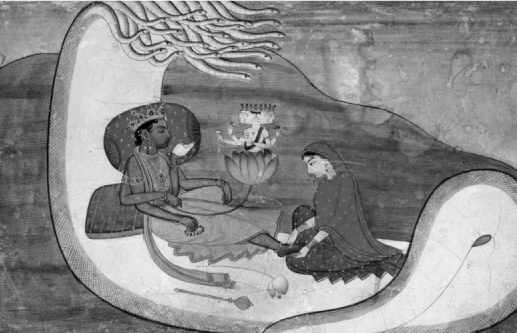Indian MythologyThe Indian Creation |
What are the Hindu creation myths? |
There are many Hindu creation myths, beginning with those of the Rigveda. An early Vedic myth tells of a golden cosmic egg of mysterious origin as the beginning of creation. Another says that Dyaus (the Sky Father) and Prithvi (the Earth Mother) joined to begin things. An important Vedic creation myth is the one in which the god Indra defeats the demon Vritra (Chaos). By defeating Chaos, the gods made the way to creation (order) possible. Still other myths center on the cosmic being, Purusha, whose dismemberment, or sacrifice, formed the basis of creation, much as in Mesopotamia and in the Norse world the dismembered parts of early beings became aspects of the world. An important creator was Prajapati (or several prajapatis), who was replaced in later myths by Brahma. Some say that Brahma created humans by making sons from his mind. Others say he or Prajapati created a woman in his mind and joined with her to create the world. In the Prajapati version of this myth, the creator finds himself alone in the universe, so he creates a man and a woman out of himself. But the woman, fearing incest, flees in the form of various animals, only to be chased and mated with by the man, who takes the male form of these animals. The result is the creation of the animal world. In the mythology of the later Puranas, in which particular gods of the Shiva/Vishnu/Devi triad dominate, we find creation myths in which each of these gods, who for their followers are the supreme being, like the Brahman of the Upanishads, contains the universe itself and thus is its de facto creator. In one Vishnu myth we find the earth-diver form of creation, in which an agent of the god Vishnu dives into the maternal depths to bring up the earth. In a popular Vishnu creation myth, Vishnu and his wife Lakshmi sleep on eternity, which is represented by the thousand-headed world serpent Ananta Shesha. The world exists during that sleep only in the god’s mind. It is when Vishnu awakens and meditates on his thought that the re-creation of the world begins. At this point the old creator god Brahma is perched on a lotus blossom, which has grown out of the navel of the much greater god Vishnu, the real creator. Brahma becomes merely the agent of Vishnu’s thought.
Still another creation myth involving Vishnu is the one about the churning of the Ocean of Milk. There are various sources for this myth, including the Mahabharata and the Puranas. According to most versions, it was Vishnu (also called Narayana) who urged the gods (devas) and the demons (asuras) to churn the primeval waters so as to find the lost Soma, the ambrosia that provides the gods with immortality. The gods had the world serpent Ananta (Vasuki or Shesha) uproot the world mountain, Meru (Mandara) and place it on the back of the Vishnu avatar, the Great Tortoise. The mountain became the churning stick and the serpent the churning cord. During the churning process Soma flowed into the sea, making it milk, and with the continued churning, elements of the world emerged.
A consistent theme among the many Hindu creation stories is the concept of ages, the kalpa, a period of 8.64 trillion years in human time, or a day and a night in terms of Brahma’s time. At the end of each kalpa, creation is destroyed, much as in the Norse Ragnarok. And each destruction—like each individual’s life—is followed by a new creation.

Vishnu creates Brahma, who is perched on a lotus blossom, during the creation of the universe. In Hindu mythology, Vishnu is a greater god than Brahma, who is only the agent of Vishnu’s thoughts.
